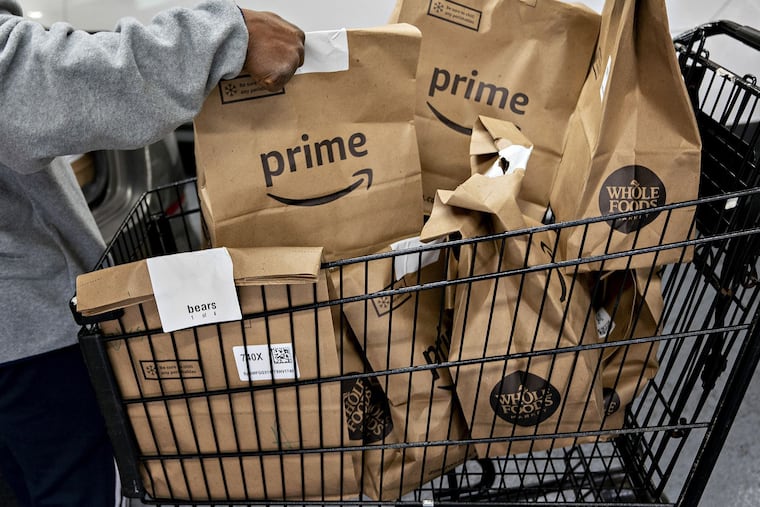Lockdowns long over, Americans are still hooked on online grocery shopping
Online grocery shopping looks like it will be one of the few pandemic behaviors that really does stick.

Online grocery shopping looks like it will be one of the few pandemic behaviors that really does stick.
The arrival of COVID-19 disrupted lifestyles, and prognosticators weighed in on the long-term changes that would bring. Now, even as Americans list their Peloton bikes on Craigslist, cancel their Netflix accounts and slow down their home-remodeling plans, they refuse to give up the convenience of online grocery shopping.
Against a backdrop of the highest inflation in four decades, now around 8.5%, shoppers are still willing to pay a premium for that convenience. There's also mounting evidence that consumers are trading down amid all these price hikes, and yet e-grocery revenue is still rising.
» READ MORE: What record-high inflation means for your household
After posting year-over-year declines in March and April, online grocery sales rebounded and have increased in the past three months, according to data from Brick Meets Click and Mercatus Technologies Inc., which both provide online services to food retailers. That includes July, when sales rose 17% from last year’s, reaching $7.8 billion. Though it has come down from its pre-vaccine heights, overall, the average monthly sales thus far in 2022 are four times as high as the pre-COVID sales rate, David Bishop of Brick Meets Click told Bloomberg. The number of monthly active users has more than doubled since August 2019.
“Grocery benefits from the fact that it’s an essential, everyday necessity,” Bishop said, which creates a “figurative moat” around it, protecting it from consumer pullback. Consumers are navigating a number of factors in deciding to use e-grocery, including inflation but also possible COVID infection, marketing promotions and convenience, he said. Within the category there’s still trading down, to store brands from national brands or to mass retailers from supermarkets. But overall, Americans need groceries, and many of them are choosing to stock up online, even if it’s more expensive.
Plus, said Alex Frederick, an analyst at Pitchbook, offering the option to pick orders up at stores eliminates pricey delivery fees and has helped retain customers. Allowing shoppers to quickly compare prices from other sites before checking out is also a "significant benefit" of e-grocery during a high-inflation environment, he said.
» READ MORE: Hot dogs vs. deli meat; rising costs shape choices at Walmart
Though the pandemic didn’t create e-grocery, it bolstered it substantially by turning it into a necessary option for many who wanted to reduce their chances of getting COVID by avoiding public places. That sped up investments and the rollout of services, such as picking up orders at stores. To meet their customers’ needs quickly, many chains signed deals with with Instacart Inc., an online grocery service, to pick items from their stores and deliver them.
Many online food retailers now are finding that even inflation-wary consumers are willing to spend more for the right products and good service.
"At any moment, you can find something more cheaply, I'm not going to argue with that," said Dave Bass, managing director for Ahold Delhaize's FreshDirect, a New York-area e-grocer. Still, the company continues to see gains in new customers, which Bass said is because of its focus on freshness and premium offerings. "We have a consumer base that wants and expects the high quality."
It's not just the higher end of the market that is bucking expectations. Discount online supermarket Misfits Market has also generated significant growth, Chief Executive Officer Abhi Ramesh said. As consumers seek more value, Misfits' average order size has grown 40% in the first half of 2022 compared with the same period last year.
Thrive Market, a discount online seller in the organic and natural categories, is also seeing higher sales, according to CEO Nick Green. As prices at the store go up, Thrive membership becomes more valuable for shoppers who don't want "to shop down to unhealthy processed-foods options," he said. Prices on the site haven't risen significantly, he said. Instead, it has started offering volume discounts and more free samples with orders.
Meanwhile, major grocers and mass retailers have invested heavily in e-commerce. Kroger is building food distribution centers that will rely on robots. Walmart expanded a service to deliver groceries to customers' refrigerators. Amazon.com, which jump-started the growth in e-grocery with its purchase of Whole Foods Market in 2017, has a similar offering that drops off orders in a home's garage. And like many chains, Target quickly bolstered its curbside pickup during the pandemic.
But as competition has intensified, with supermarkets creating their own e-commerce sites and food-delivery giants DoorDash Inc. and Uber Inc. also jumping into the expanding category, industry bellwether Instacart saw a major investor slash its valuation in July. Instacart declined to comment.
For many consumers, the competition is a boon: More products and ways to get them, and sometimes more discounts and freebies, too. Even without the promotions, though, the convenience of online grocery shopping is proving to be worth the higher price, even if name-brand peanut butter isn't. "Behaviors are stabilizing," Bishop said, and buying groceries online is now an "embedded, new routine for a sizable group."
Bloomberg’s Brendan Case and Jackie Davalos contributed to this report.